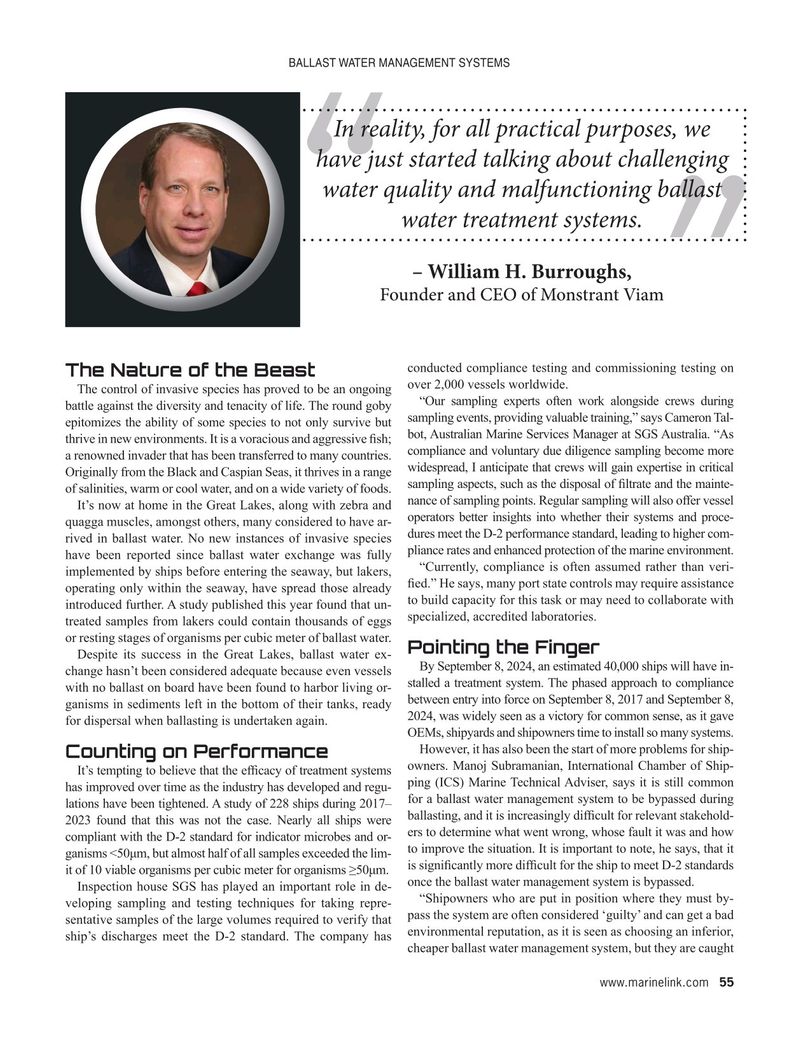
Page 55: of Maritime Reporter Magazine (August 2024)
Read this page in Pdf, Flash or Html5 edition of August 2024 Maritime Reporter Magazine
BALLAST WATER MANAGEMENT SYSTEMS
In reality, for all practical purposes, we have just started talking about challenging water quality and malfunctioning ballast water treatment systems.
– William H. Burroughs,
Founder and CEO of Monstrant Viam conducted compliance testing and commissioning testing on
The Nature of the Beast
The control of invasive species has proved to be an ongoing over 2,000 vessels worldwide.
“Our sampling experts often work alongside crews during battle against the diversity and tenacity of life. The round goby epitomizes the ability of some species to not only survive but sampling events, providing valuable training,” says Cameron Tal- thrive in new environments. It is a voracious and aggressive ? sh; bot, Australian Marine Services Manager at SGS Australia. “As compliance and voluntary due diligence sampling become more a renowned invader that has been transferred to many countries. widespread, I anticipate that crews will gain expertise in critical
Originally from the Black and Caspian Seas, it thrives in a range sampling aspects, such as the disposal of ? ltrate and the mainte- of salinities, warm or cool water, and on a wide variety of foods.
It’s now at home in the Great Lakes, along with zebra and nance of sampling points. Regular sampling will also offer vessel operators better insights into whether their systems and proce- quagga muscles, amongst others, many considered to have ar- rived in ballast water. No new instances of invasive species dures meet the D-2 performance standard, leading to higher com- have been reported since ballast water exchange was fully pliance rates and enhanced protection of the marine environment. “Currently, compliance is often assumed rather than veri- implemented by ships before entering the seaway, but lakers, operating only within the seaway, have spread those already ? ed.” He says, many port state controls may require assistance to build capacity for this task or may need to collaborate with introduced further. A study published this year found that un- treated samples from lakers could contain thousands of eggs specialized, accredited laboratories.
or resting stages of organisms per cubic meter of ballast water.
Pointing the Finger
Despite its success in the Great Lakes, ballast water ex-
By September 8, 2024, an estimated 40,000 ships will have in- change hasn’t been considered adequate because even vessels stalled a treatment system. The phased approach to compliance with no ballast on board have been found to harbor living or- ganisms in sediments left in the bottom of their tanks, ready between entry into force on September 8, 2017 and September 8, 2024, was widely seen as a victory for common sense, as it gave for dispersal when ballasting is undertaken again.
OEMs, shipyards and shipowners time to install so many systems.
However, it has also been the start of more problems for ship-
Counting on Performance
It’s tempting to believe that the ef? cacy of treatment systems owners. Manoj Subramanian, International Chamber of Ship- ping (ICS) Marine Technical Adviser, says it is still common has improved over time as the industry has developed and regu- for a ballast water management system to be bypassed during lations have been tightened. A study of 228 ships during 2017– 2023 found that this was not the case. Nearly all ships were ballasting, and it is increasingly dif? cult for relevant stakehold- ers to determine what went wrong, whose fault it was and how compliant with the D-2 standard for indicator microbes and or- to improve the situation. It is important to note, he says, that it ganisms <50µm, but almost half of all samples exceeded the lim- is signi? cantly more dif? cult for the ship to meet D-2 standards it of 10 viable organisms per cubic meter for organisms =50µm.
once the ballast water management system is bypassed.
Inspection house SGS has played an important role in de- “Shipowners who are put in position where they must by- veloping sampling and testing techniques for taking repre- sentative samples of the large volumes required to verify that pass the system are often considered ‘guilty’ and can get a bad ship’s discharges meet the D-2 standard. The company has environmental reputation, as it is seen as choosing an inferior, cheaper ballast water management system, but they are caught www.marinelink.com 55
MR #8 (50-65).indd 55 8/8/2024 4:07:10 PM

 54
54

 56
56
